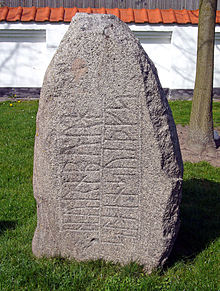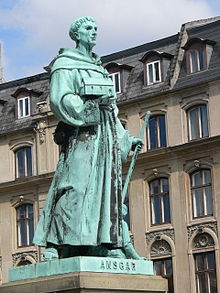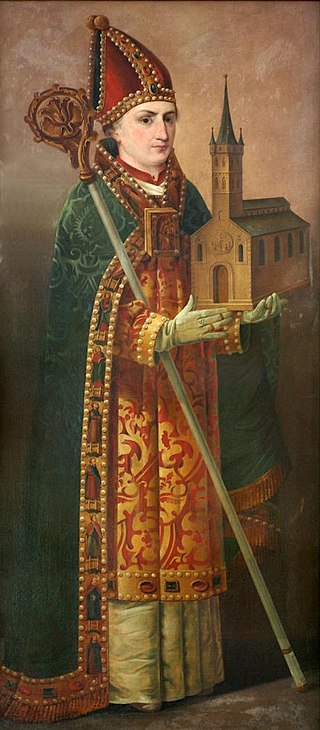
Ansgar, also known as Anskar, Saint Ansgar, Saint Anschar or Oscar, was Archbishop of Hamburg-Bremen in the northern part of the Kingdom of the East Franks. Ansgar became known as the "Apostle of the North" because of his travels and the See of Hamburg received the missionary mandate to bring Christianity to Northern Europe.

Sweyn Forkbeard was King of Denmark from 986 until his death, King of England for five weeks from December 1013 until his death, and King of Norway from 999/1000 until 1013/14. He was the father of King Harald II of Denmark, King Cnut the Great, and Queen Estrid Svendsdatter.

Harald "Bluetooth" Gormsson was a king of Denmark and Norway.
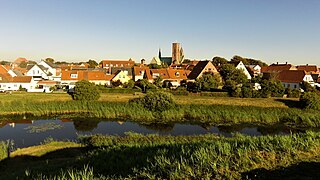
Ribe is a town in south-west Jutland, Denmark, with a population of 8,365 (2023). It is the seat of the Diocese of Ribe covering southwestern Jutland. Until 1 January 2007, Ribe was the seat of both a surrounding municipality and county. It is now part of the enlarged Esbjerg Municipality in the Region of Southern Denmark. It has been called the oldest town in Denmark.

Swedish pre-history ends around 800 AD, when the Viking Age begins and written sources are available. The Viking Age lasted until the mid-11th century. Scandinavia was formally Christianized by 1100 AD. The period 1050 to 1350—when the Black Death struck Europe—is considered the Older Middle Ages. The Kalmar Union between the Scandinavian countries was established in 1397 and lasted until King Gustav Vasa ended it upon seizing power. The period 1350 to 1523 – when king Gustav Vasa, who led the unification of Sweden in the Swedish War of Liberation, was crowned – is considered the Younger Middle Ages. During these centuries, Sweden gradually consolidated as a single nation.
Saint Rimbert was archbishop of Hamburg-Bremen, in the northern part of the Kingdom of East Frankia from 865 until his death in 888. He most famously wrote the hagiography about the life Ansgar, the Vita Ansgari, one of the most popular hagiographies of middle ages.
The Vita Ansgarii, also known as the Vita Anskarii, is the hagiography of saint Ansgar, written by Rimbert, his successor as archbishop in the Prince-Archbishopric of Bremen. The Vita is an important source not only in detailing Ansgar's Scandinavian missionary work, but also in its descriptions of the everyday lives of people during the Viking Age.
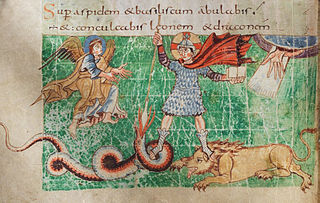
The Germanic peoples underwent gradual Christianization in the course of late antiquity and the Early Middle Ages. By AD 700, England and Francia were officially Christian, and by 1100 Germanic paganism had also ceased to have political influence in Scandinavia.
Olof was a Swedish monarch or local ruler who ruled over Birka, an important port town, and possibly Uppsala, an important early Swedish political center, in about 852, when the Catholic missionary Saint Ansgar made his second voyage from Germany to Birka in about the year 851 or 852 A.D. He had an ambivalent attitude to Christianity, and was known as a successful warrior king in the Baltic region.
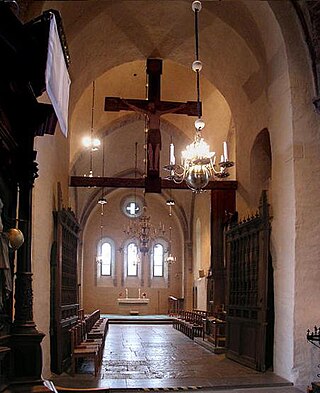
Stenkil was a King of Sweden who ruled c. 1060 until 1066. He succeeded Emund the Old and became the first king from the House of Stenkil. He is praised as a devout Christian, but with an accommodating stance towards the old Pagan religion. His brief reign saw an armed conflict with Norway.

Saint Sigfrid of Sweden (Swedish: Sigfrid, Latin: Sigafridus, Old Norse: Sigurðr, Old English: Sigefrið/Sigeferð) was a missionary-bishop in Scandinavia during the first half of the 11th century. Originally from England, Saint Sigfrid is credited in late medieval king-lists and hagiography with performing the baptism of the first steadfastly Christian monarch of Sweden, Olof Skötkonung. He most likely arrived in Sweden soon after the year 1000 and conducted extensive missions in Götaland and Svealand. For some years after 1014, following his return to England, Sigfrid was based in Trondheim, Norway. However, his position there became untenable after the defeat of Olaf Haraldsson.

The Christianization of Scandinavia, as well as other Nordic countries and the Baltic countries, took place between the 8th and the 12th centuries. The realms of Denmark, Norway and Sweden established their own archdioceses, responsible directly to the pope, in 1104, 1154 and 1164, respectively. The conversion to Christianity of the Scandinavian people required more time, since it took additional efforts to establish a network of churches.
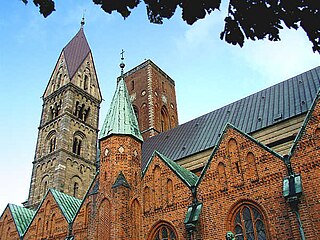
The former Diocese of Ribe was a Roman Catholic diocese in Southern Jutland, Denmark. The diocese was established in 948, and dissolved in 1536 during the Protestant Reformation. Within the newly established protestant Church of Denmark, the Diocese of Ribe effectively replaced its Roman Catholic precursor.
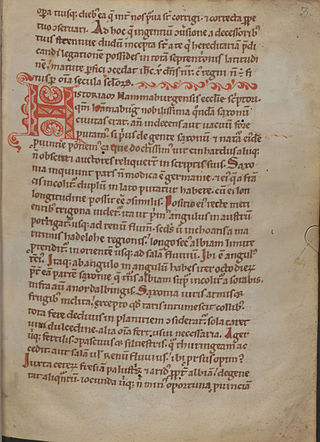
Gesta Hammaburgensis ecclesiae pontificum is a historical treatise written between 1073 and 1076 by Adam of Bremen, who made additions (scholia) to the text until his death . It is one of the most important sources of the medieval history of Northern Europe, and the oldest textual source reporting the discovery of coastal North America.

Horik I or Hårik was a king of the Danes. He was co-ruler from 813, and sole king from c. 828 until his violent death in 854. His long and eventful reign was marked by Danish raids on the Carolingian Empire of Louis the Pious, son and successor of Charlemagne.
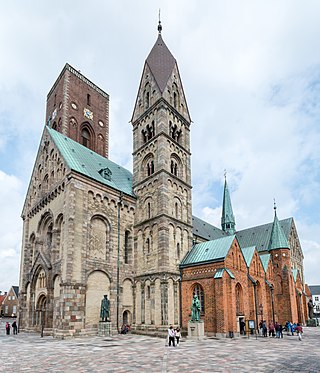
Ribe Cathedral or Our Lady Maria Cathedral is located in the ancient city of Ribe, on the west coast of southern Jutland, Denmark. It was founded in the Viking Era as the first Christian church in Denmark by Ansgar, a missionary monk from Hamburg, under permission of the pagan King Horik I. The cathedral has experienced several damaging events throughout its long history and has been restored, expanded and decorated repeatedly. As it stands today, Ribe Cathedral is the best preserved Romanesque building in Denmark, but reflects a plethora of different architectural styles and artistic traditions. It ranks among the most popular tourist attractions in Denmark and has been awarded two stars in the Michelin guide.

Horik II, also known as Hårik or, in late sources, Erik Barn, was King of the Danes from the fall of Horik I in 854 to an unknown date between 864 and 873. During his reign the Danish kingdom showed tendencies of breaking up. After his demise under unknown circumstances, Denmark entered a long period of obscurity, until the rise of the Jelling dynasty in the 10th century.

In the 9th century, Christianity was spreading throughout Europe, being promoted especially in the Carolingian Empire, its eastern neighbours, Scandinavia, and northern Spain. In 800, Charlemagne was crowned as Holy Roman Emperor, which continued the Photian schism.
The history of Christianity in Norway started in the Viking Age in the 9th century. Trade, plundering raids, and travel brought the Norsemen into close contacts with Christian communities, but their conversion only started after powerful chieftains decided to receive baptism during their stay in England or Normandy. Haakon the Good was the first king to make efforts to convert the whole country, but the rebellious pagan chieftains forced him to apostatize. Olaf Tryggvason started the destruction of pagan cult sites in the late 10th century, but only Olaf Haraldsson achieved the official adaption of Christianity in the 1020s. Missionary bishops subjected to the archbishops of Hamburg-Bremen were responsible for the spread of the new faith before the earliest bishoprics were established around 1100.
Björn was a Swedish monarch or local ruler who ruled over Birka, an important port town, and possibly Uppsala, an important early Swedish political center, around the year 829. His existence is attested by the nearly contemporary account Vita Ansgari, written by the missionary Rimbert, who visited Sweden alongside Ansgar in c. 852. He is in fact the first Swedish figure referred as king who is known from a reasonably reliable source. Older Swedish historiography often identified the king with the legendary figure Björn at Haugi, who was supposedly a Swedish ruler in the generation before the youth of Harald Finehair of Norway. This identification is however considered unverifiable, since Björn at Haugi may have actually been a Norwegian local ruler who was later constructed as a Swedish king. Although the genealogy of early Swedish local rulers is not known, Björn is assumed to have belonged to the House of Munsö, which would later produce Eric the Victorious, generally considered to be Sweden's first king. The royal names attested in the ninth century, namely, also occur among the kings and princes in the late Viking age, perhaps suggesting a genealogical continuity.
